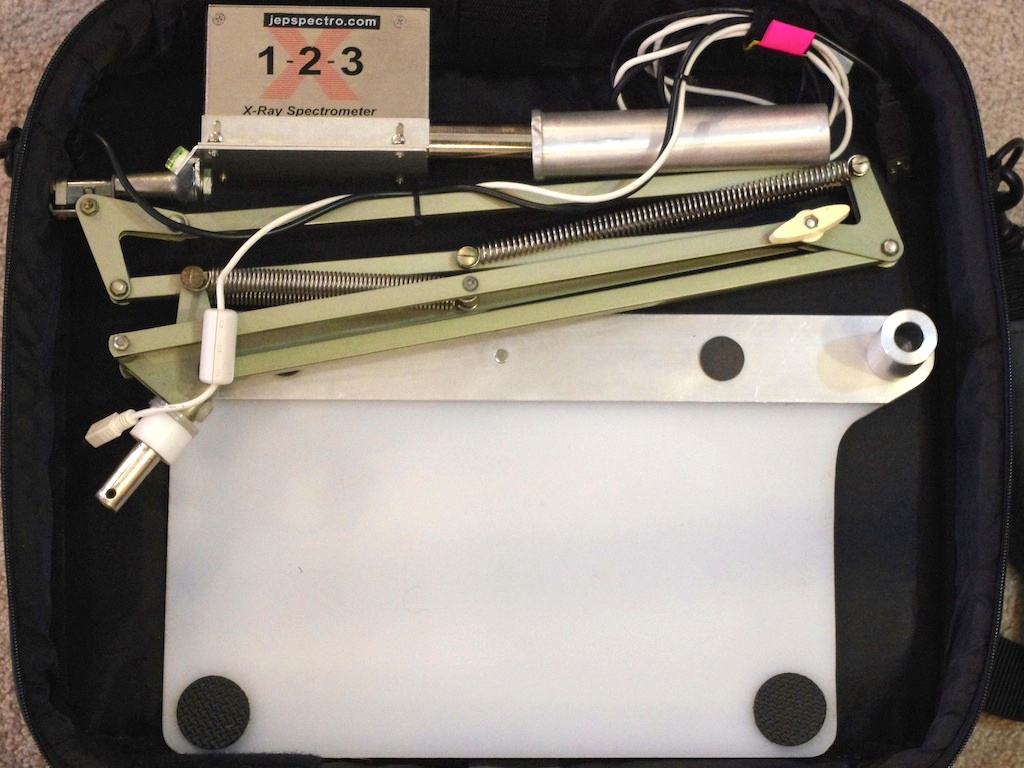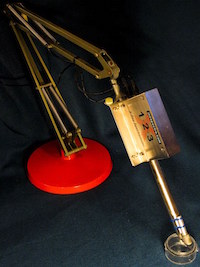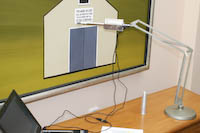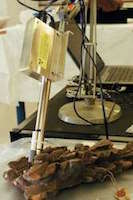Amptek X-123 X-ray Spectrometer
Updated 14 January 2024

Contents
Use the browser "back control" to return here.
- Introduction
- Specifications, Energy Range, Elements Efficiency, Geometry, Source Shielding, Count Rate, Analysis, Amptek X-ray emission K & L line lookup chart,
- Operation
- Applications Portable Operation, Te Papa and National Library, Industrial Samples, Spectra, Compton Scattering, Aluminium Filter, Element Count Rates,
- Portable X-ray Spectrometer
Introduction
An Amptek X-123 X-ray spectrometer has been mounted on an Equipoise lamp arm along with a 1 µC 241Am source from a domestic smoke alarm. This allows X-ray fluorescence spectrometry to carried out on various objects without touching or altering them. The intended use is as a survey instrument to identify samples requiring further work. In many cases just a basic elemental identification is all that is needed.
This instrument has been used to support many interesting educational projects, some of which are illustrated here. Operation of the X-ray spectrometer is simple and safe as the source activity is very low. The design uses a very compact source-detector geometry which makes up for the low source activity. An added benefit of the compact geometry is better detection of light elements. It can run for many hours, using just a laptop computer as the source of power. The system is portable and it fits in the same bag as the computer.
This instrument can longer be used as the detector has finally failed due to a window fault after more than 10 years of continuous use on many projects. Over time some users have purchased up-to-date portable x-ray analysers for their own use, once they saw what this simple instrument could do. I hope I can get the equipment working again, maybe with a mylar window in a light-proof housing or perhaps under vacuum for light element detection. A new PIN detector is the best option for future use. In addition a ROM upgrade is needed for use with modern Windows computers.
Specifications
Energy Range
The useful X-ray energy range is about 1 to 100 keV, depending on the detector window and the silicon detector thickness. The energy resolution is about 150 eV.
Elements
Elements from sodium to uranium can be detected with my X-ray spectrometer. Sensitivity is lowered for both light and heavy elements. For light elements absorption of X-rays by the sample matrix, air, and the 12.5 micron thick detector window, reduces sensitivity. For heavy elements the 500 micron thickness of the detector crystal results in incomplete absorption of high energy X-rays.
Efficiency
The efficiency of the spectrometer is greater than 80% of the maximum for the K lines of P, at 2 keV, to Sr, at 14.16 keV. For L lines the range is from from Y, at 1.92 keV, and U, at 13.61 keV. Good detector efficiency is therefore available for almost the entire periodic table. Efficiency curves are available at the Amptek web site.
Geometry
To detect the lightest elements, the distance from the sample to the detector needs to be small. Alternatively, the path from the detector to the sample could be evacuated, or purged with helium. The paint brush fibre at the source tip helps to set a standard working distance. A bubble level behind the spectrometer body is used to set the preferred source-sample-detector geometry.
Source Shielding
The source is shielded from the detector by a 1.75mm thick lead sheet barrier. The shield is curved and bevelled so that a thin Pb edge is not seen by the detector or the source. This is important, as a non bevelled shield produced a significant Pb background. Another lead barrier stops X-rays emitted through the back of the source. The very low activity of the shielded (or unshielded) source makes it safe for general use. Approaching the source from the side or above, with a scintillation counter, did not reveal any counts above background. The source, lead shielding and the beryllium detector window can be seen in several photos. The lead shielding is coated with a thin layer of clear nail varnish to prevent any lead contamination of objects under study.

Count Rate
Typically only a few counts per second are observed as fluorescence, so it usually takes a few minutes to see the beginnings of a spectrum. Even so, the instrument has proven to be remarkably useful. At right, for example, it is shown detecting significant amounts of lead in a picture frame frieze. This conclusion took only a few minutes.
Analysis
There are some samples where the interpretation can be easily taken further to give a good analysis. The analysis of brass is a good example because copper and zinc are adjacent in the periodic table and the X-ray energies are therefore similar. In other cases some sample preparation and the use of suitable XRF software is required.
Amptek X-ray emission K & L line lookup chart
Using the included software, X-ray spectra can be interpreted by using an Amptek X-ray emission K & L line lookup chart. This Amptek X-ray software link includes a quantitative XRF program and legacy software..
Operation
The X-ray spectrometer is powered from a USB port on a laptop computer. A second USB port is used for data input. Alternatively a supplied 5 volt power supply may be used. I also have a battery power supply.
The laptop computer wireless network port should be turned off to prevent radio frequency interference adding to the X-ray spectrum. The X-ray spectrometer should not be bumped or subjected to vibration as the low energy part of the spectrum may be affected.
Applications
Portable Operation
The X-ray spectrometer has been used for a few hours as a completely portable instrument. Power to run the X-ray spectrometer was obtained from the laptop batteries via a spare USB port. A number of valuable paintings were measured, in situ, as part of a study of white pigments by Salme Kortet, a student in the School of Chemical and Physical Sciences at Victoria University of Wellington (2008), and more recently at Te Papa. The introduction of various white pigments used in paintings depends on the age of the painting. This useful Pigment colour index shows the white pigments available today. Titanium pigments were introduced in 1921 while Lithopone dates back to about 1870. Lead white has been used for more than 2000 years.

At right a gold leaf coated picture frame is being examined for the presence of silver or copper.
Te Papa and National Library
The X-ray spectrometer has been used to look at various artefacts at Te Papa and the National library. A barium-zinc based coating (Lithopone) was observed on a carving. Sodium, magnesium and iron were found in a dried seawater stain on a logbook by Captain Cook. A map backing examined contained zinc and, unexpectedly, mercury. In all cases the object was not touched, sampled or altered.
Industrial Samples
Industrial samples include metal fragments from a wind turbine bearing and fine metal particles from a positioning motor on a drilling rig. The X-ray spectrometer was also used to examine paint defects at an art exhibit in TheNewDowse
The following spectrum shows the XRF spectrum of a computer printed circuit board.
X-ray energies corresponding to Ni, Cu, Pb, Au and Br are at significant levels.
Br is part of a common fire retardant and is now banned in many countries.
For this spectrum I was more interested in the board, rather than the traces and soldering.
The noise observed at low energies has now been eliminated by using better source shielding.

Spectra
A collection of Miscellaneous XRF spectra was obtained with this spectrometer. The plots are 60 keV wide so a simple scale could be made to read off the X-ray energies directly.
Compton Scattering
Some of the spectra of lower density samples show broad Compton scattering peaks derived mainly from the strong americium lines at 13.95 and 17.94 keV. Fortunately these broad, lower energy, scattering peaks are clear of most of the useful X-ray lines. Good examples are seen in the the spectra of alum, mica, Polymorph pellets and Tanalised wood. Higher density samples show less scattering.
Aluminium Filter
A 4 mm thick pure aluminium filter can be used to remove the lower energy americium lines leaving a useful exciting line at 59.54 keV. The time needed to get a clean spectrum is increased substantially, but the Compton scattering from the 13.95 and 17.94 keV lines is eliminated.
Element Count Rates
For interest, I have plotted the detector counts per minute for the following elements: Al Si Ti Mn Fe Ni Cu Zn Se Zr Mo Ag Sn presented as flat polished surfaces. I also used some barium carbonate powder and calculated the equivalent element response. The low count rates are not really a problem as most projects I work on have only a small number of samples, so I can wait.

The first upward part of the curve is logarithmic. It represents the X-ray absorption due to the thickness of the beryllium window on the detector. The absorption by the window reduces as the X-ray energy increases. The downward part of the curve represents the reducing probability that an X-ray photon will deposit all of its energy within the detector thickness via the photoelectric effect. An increasing number of X-ray photons will pass right through the detector as the energy rises. In a vacuum, and without a window, this curve should level out at lower energies where total absorption of an X-ray photon by the detector will occur. The profile should look like a reversed integral sign. Combining the two curves produces the observed shape.
Portable X-ray Spectrometer
To assist in transporting the spectrometer I have made some changes to the mounting. I removed the Equipoise arm from the heavy base. I made a flat base which fits under the computer and provides a stable support for the X-ray spectrometer on the Equipoise arm. The Equipoise arm and the spectrometer can be folded and fitted into a briefcase along with the flat base, computer and accessories. The packed arrangement is shown at right and the working spectrometer is shown at the top. Additional packing will be added to separate the items. The weight, including the bag, is 8 kg.


JEPSPECTRO - Home Page
Email: replace at with @
jepattersonatactrix.co.nz
JEP Links
JEP Related LinksAmptek
X-ray Software.
Te Papa
National library
TheNewDowse
Lithopone
VUW School of Chemical and Physical Sciences
Pigment colour index
Amptek X-ray emission K & L line lookup chart
XRF spectra
Click the photos below to enlarge. Use the browser "back control" to return.
 Amptek X-ray spectrometer
Amptek X-ray spectrometer
 White pigment study
White pigment study
 Reflection in silicon wafer
Reflection in silicon wafer
 Captain Cook's logbook. Seawater stain
Captain Cook's logbook. Seawater stain
 Chlorine in a PVC toy
Chlorine in a PVC toy
 Flax fibre study
Flax fibre study
 Gold plated brass replica medal.
Gold plated brass replica medal.
 Taxidermy - looking for arsenic in an albatross
Taxidermy - looking for arsenic in an albatross
 Amptek X-ray spectrometer and part of a picture frame with high lead levels
Amptek X-ray spectrometer and part of a picture frame with high lead levels
 Taxidermy - arsenic in a penguin
Taxidermy - arsenic in a penguin
 X-ray measurement of silver in gold leaf covered picture frame
X-ray measurement of silver in gold leaf covered picture frame
 Lithopone on a carving. Zinc, sulphur and barium were the major elements detected
Lithopone on a carving. Zinc, sulphur and barium were the major elements detected
 Captain Cook's logbook. Identifying excess magnesium in a seawater stain
Captain Cook's logbook. Identifying excess magnesium in a seawater stain
 Antique sapphire pendant. Aluminium was the main element detected
Antique sapphire pendant. Aluminium was the main element detected
 Packed X-ray spectrometer
Packed X-ray spectrometer